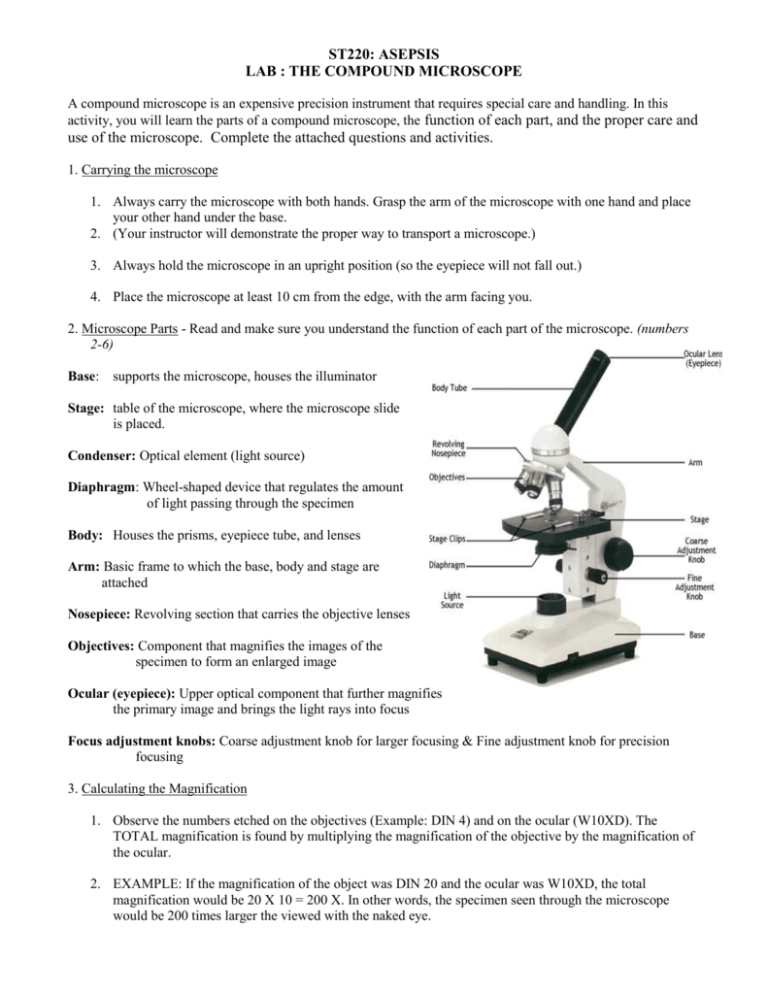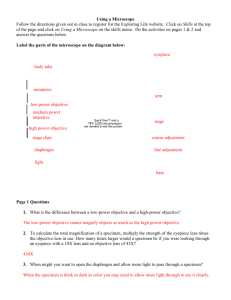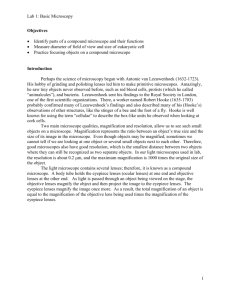ST220_MicroscopeLab_Instructions
advertisement

ST220: ASEPSIS LAB : THE COMPOUND MICROSCOPE A compound microscope is an expensive precision instrument that requires special care and handling. In this activity, you will learn the parts of a compound microscope, the function of each part, and the proper care and use of the microscope. Complete the attached questions and activities. 1. Carrying the microscope 1. Always carry the microscope with both hands. Grasp the arm of the microscope with one hand and place your other hand under the base. 2. (Your instructor will demonstrate the proper way to transport a microscope.) 3. Always hold the microscope in an upright position (so the eyepiece will not fall out.) 4. Place the microscope at least 10 cm from the edge, with the arm facing you. 2. Microscope Parts - Read and make sure you understand the function of each part of the microscope. (numbers 2-6) Base: supports the microscope, houses the illuminator Stage: table of the microscope, where the microscope slide is placed. Condenser: Optical element (light source) Diaphragm: Wheel-shaped device that regulates the amount of light passing through the specimen Body: Houses the prisms, eyepiece tube, and lenses Arm: Basic frame to which the base, body and stage are attached Nosepiece: Revolving section that carries the objective lenses Objectives: Component that magnifies the images of the specimen to form an enlarged image Ocular (eyepiece): Upper optical component that further magnifies the primary image and brings the light rays into focus Focus adjustment knobs: Coarse adjustment knob for larger focusing & Fine adjustment knob for precision focusing 3. Calculating the Magnification 1. Observe the numbers etched on the objectives (Example: DIN 4) and on the ocular (W10XD). The TOTAL magnification is found by multiplying the magnification of the objective by the magnification of the ocular. 2. EXAMPLE: If the magnification of the object was DIN 20 and the ocular was W10XD, the total magnification would be 20 X 10 = 200 X. In other words, the specimen seen through the microscope would be 200 times larger the viewed with the naked eye. 4. Cleaning the lenses (See question 7) 1. Lens Paper should be used to clean any of the lenses of the microscope. Lens paper is provided to you by your instructor. Never use anything other then lens paper to clean the lens on the microscope, including your fingers. 5. Illumination (applies to questions 8-10) 1. After you plug the microscope in and turn on the illuminator, rotate the Iris diaphragm on the underside of the stage in order to adjust the light intensity. Look through the microscope as you adjust the diaphragm and observe the changes. Set the diaphragm and move on. 2. Keeping the light intensity in mind, look through the microscope and move through the different magnifications slowly. Observe the change in light intensity. 3. Adjust the intensity of light to match the requirements of the objective you are wishing to view. 6. Focusing on low power 1. Place a prepared microscope slide, provided to you by your instructor, on the top of the stage (cover slip up) surface 2. Position the 4X objective lens into the optical path, making sure that the lens clicks into position. 3. Look at the microscope with your head to the side. Locate the coarse adjustment knob which moves the stage up and down. Practice moving the coarse adjustment knob, seeing how it moves the stage with each turn of the knob. Using the coarse adjustment knob, move the stage down as far as it will go. This is the starting position when you first begin to bring an object into focus. Look into the eyepiece. Slowly, move the stage up by using the coarse adjustment knob until it comes into focus. Never allow the slide to come in contact with the objective lens. 4. Turn the fine adjustment knob to bring the specimen into sharp focus. 5. You may need to change the aperture (opening) of the iris diaphragm to control the brightness. It depends on the specimen and the magnification you are using. 7. Moving to a higher magnification -Do not touch the slide with the lens. 1. Rotate the revolving nosepiece to position 10X objective into the optical path. Use ONLY the fine adjustment knob to bring the image into sharp focus. 2. Rotate the revolving nosepiece to position 40X objective into the optical path. Use ONLY the fine adjustment knob to bring the image into sharp focus. **** NEVER use the coarse adjustment when focusing on the medium and high power objectives!!!!!









